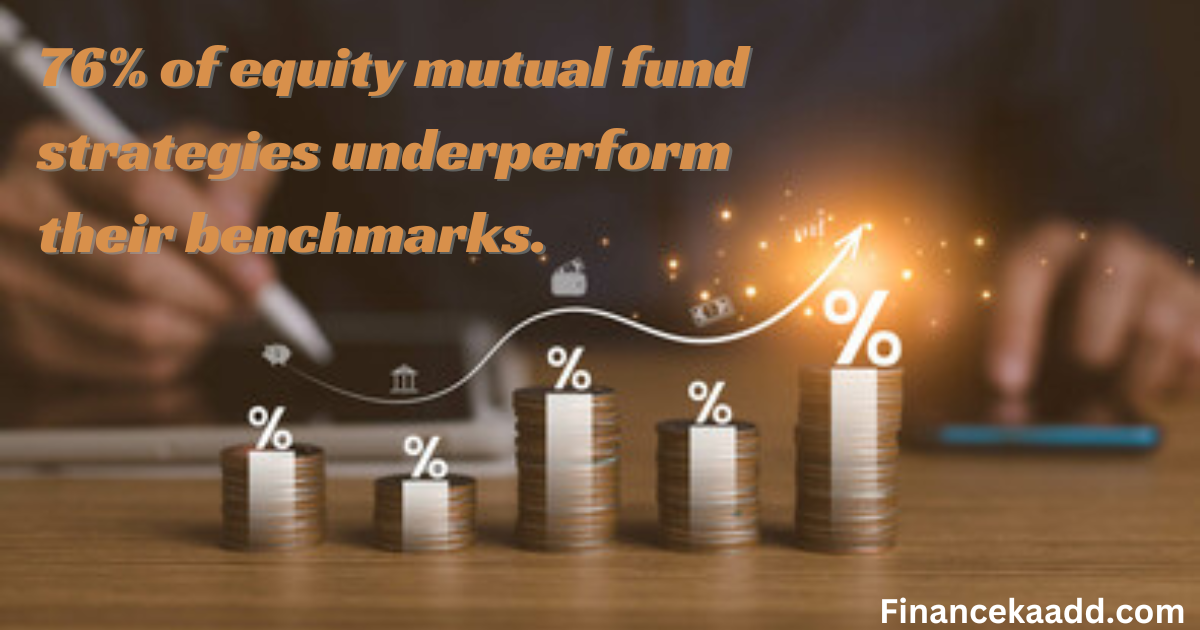76% of equity mutual fund strategies are one of the most popular investment options in India, as they offer diversification, professional management, and liquidity to investors. However, not all mutual funds are able to deliver consistent and superior returns over the long term. In fact, according to an analysis by ETMutualFunds1, around 76% of equity mutual fund schemes have failed to beat their respective benchmarks in the seven-year horizon.
In this blog post, we will explore the reasons behind this underperformance, the categories and schemes that have outperformed or underperformed their benchmarks, and some tips on how to choose the right mutual funds for your portfolio.
What are benchmarks, and 76% of equity mutual fund strategies
A benchmark is a standard or reference point that is used to measure and compare the performance of a mutual fund scheme. A benchmark can be an index, such as Nifty 50 or Sensex, or a customized basket of securities that reflects the investment objective and strategy of the scheme.
Benchmarks are important because they help investors evaluate how well a mutual fund scheme is doing in relation to its peers and the market. A mutual fund scheme that beats its benchmark is said to have generated alpha, or excess returns, while a scheme that underperforms its benchmark is said to have generated negative alpha, or inferior returns.
OPEN YOUR ACCOUNT PAYTM,MONEY👉CLICK HERE
What factors contribute to influencing the performance of mutual funds?
The success of mutual funds is contingent upon a multitude of factors, including:
The fund manager’s skill, experience, and investment style
The fund’s portfolio composition, diversification, and risk-return profile
The fund’s expense ratio, turnover ratio, and exit load
The market conditions, trends, and cycles
The fund’s benchmark selection and suitability
Which categories and schemes have underperformed or outperformed their benchmarks?
For the study, ETMutualFunds considered equity categories such as large cap, mid cap, small cap, large and mid cap, flexi cap, focused fund, value and contra fund, and ELSS. They considered trailing returns for the analysis, which are the returns generated by a scheme over a specific period in the past. They only considered regular and growth-option schemes.
The analysis revealed that out of 157 equity mutual fund schemes that have completed seven years in the market, 119 schemes have failed to beat their respective benchmarks, while 38 schemes have managed to outperform their benchmarks in the seven-year horizon.
The mid-cap category was the worst hit, as out of 21 schemes, 20 schemes underperformed their benchmarks. The large and midcap categories witnessed 90% underperformance, as out of 20 schemes, 18 failed to beat their benchmarks. The focused fund and large cap categories had 86% and 83% of underperformance, respectively.
The ELSS and Flexi Cap categories had 78% and 79% of underperformance, respectively. The value fund category had 58% underperformance, while the small-cap fund category had 23% underperformance. The contrafund category was the only one that had 100% outperformance, as all three schemes in this category beat their benchmarks.
AXIS BANK MUTUAL FUNDS👉APPLY NOW
Some of the schemes that underperformed their benchmarks on the seven-year horizon are:
HDFC Mid-Cap Opportunities Fund, which offered 18.73% compared to 20.12% by its benchmark (Nifty Midcap 150-TRI),
Franklin India Prima Fund, which offered 14.96% compared to 20.12% by its benchmark (Nifty Midcap 150-TRI),
Navi Large & Midcap Fund, which offered 13.19% compared to 16.18% by its benchmark (S&P BSE 250 LargeMidCap Index, TRI),
HDFC Focused 30 Fund, which offered 11.64% compared to 16.18% by its benchmark (S&P BSE 250 LargeMidCap Index, TRI),
ICICI Prudential Bluechip Fund, which offered 14.02% compared to 15.29% by its benchmark (Nifty 100-TRI),
Some of the schemes that outperformed their benchmarks in the seven-year horizon are:
SBI Contra Fund, which offered 19.51% compared to 15.29% by its benchmark (Nifty 100-TRI),
Kotak India EQ Contra Fund, which offered 18.93% compared to 15.29% by its benchmark (Nifty 100-TRI),
Invesco India Contra Fund, which offered 18.63% compared to 15.29% by its benchmark (Nifty 100-TRI),
Nippon India Small Cap Fund, which offered 24.64% compared to 19.51% by its benchmark (Nifty Smallcap 250-TRI),
Quant Large & Mid Cap Fund, which offered 23.82% compared to 16.18% by its benchmark (S&P BSE 250 LargeMidCap Index – TRI)
BEST BOOK FOR MUTUAL FUNDS👉BUY NOW
Selecting the appropriate mutual funds for your investment portfolio: What’s the best approach?
Choosing the right mutual funds for your portfolio can be a challenging task, as there are thousands of schemes available in the market, each with different features, objectives, and performance. However, you can follow some tips to make the process easier and more effective. Here are some tips to help you pick the right mutual funds for your portfolio:
Define your investment goals, risk appetite, and time horizon. This will help you narrow down the categories and schemes that suit your profile and preferences.
Do your research and analysis. Compare the schemes based on various parameters, such as past performance, consistency, risk-adjusted returns, expense ratio, portfolio composition, fund manager’s track record, and benchmark suitability.
Diversify your portfolio. Invest in different categories and schemes that have a low correlation with each other so that you can reduce your overall risk and enhance your returns.
Review and rebalance your portfolio periodically. Monitor the performance of your schemes and the market conditions, and make adjustments to your portfolio as and when required to align it with your goals and risk tolerance.
BEST BOOK FOR MUTUAL FUNDS👉BUY NOW
Conclusion
Mutual funds are a great way to invest in the equity market, as they offer many benefits to investors. However, not all mutual funds are able to beat their benchmarks over the long term, and some categories and schemes have underperformed significantly over the past seven years. Therefore, investors need to be careful and diligent while choosing the right mutual funds for their portfolio and follow some tips to optimize their returns and minimize their risks.

